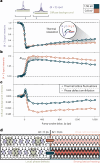Valley-controlled photoswitching of metal-insulator nanotextures
- PMID: 40678615
- PMCID: PMC12263438
- DOI: 10.1038/s41567-025-02899-5
Valley-controlled photoswitching of metal-insulator nanotextures
Abstract
Spatial heterogeneity and phase competition are hallmarks of strongly correlated materials, influencing phenomena such as colossal magnetoresistance and high-temperature superconductivity. Active control over phase textures further promises tunable functionality at the nanoscale. Although light-induced switching of a correlated insulator to a metallic state is well established, optical excitation generally lacks the specificity to select subwavelength domains and determine final textures. Here we drive the domain-specific quench of a textured Peierls insulator using valley-selective photodoping. Polarized excitation exploits the anisotropy of quasi-one-dimensional states at the charge-density-wave gap to initiate an insulator-metal transition with minimal electronic heating. We find that averting dissipation facilitates domain-specific carrier confinement, control over nanotextured phases and reduction in thermal relaxation from the metastable metallic state. This valley-selective photoexcitation approach will enable the activation of electronic phase separation beyond thermodynamic limitations, facilitating optically controlled hidden states, engineered heterostructures and polarization-sensitive percolation networks.
Keywords: Electronic properties and materials; Nanowires; Phase transitions and critical phenomena; Surfaces, interfaces and thin films.
© The Author(s) 2025.
Conflict of interest statement
Competing interestsThe authors declare no competing interests.
Figures









References
-
- de la Torre, A. et al. Colloquium: nonthermal pathways to ultrafast control in quantum materials. Rev. Mod. Phys.93, 041002 (2021).
-
- Basov, D. N., Averitt, R. D. & Hsieh, D. Towards properties on demand in quantum materials. Nat. Mater.16, 1077–1088 (2017). - PubMed
-
- Sciaini, G. et al. Electronic acceleration of atomic motions and disordering in bismuth. Nature458, 56–59 (2009). - PubMed
-
- Morrison, V. R. et al. A photoinduced metal-like phase of monoclinic VO2 revealed by ultrafast electron diffraction. Science346, 445–448 (2014). - PubMed
-
- Eichberger, M. et al. Snapshots of cooperative atomic motions in the optical suppression of charge density waves. Nature468, 799–802 (2010). - PubMed
LinkOut - more resources
Full Text Sources
Miscellaneous
